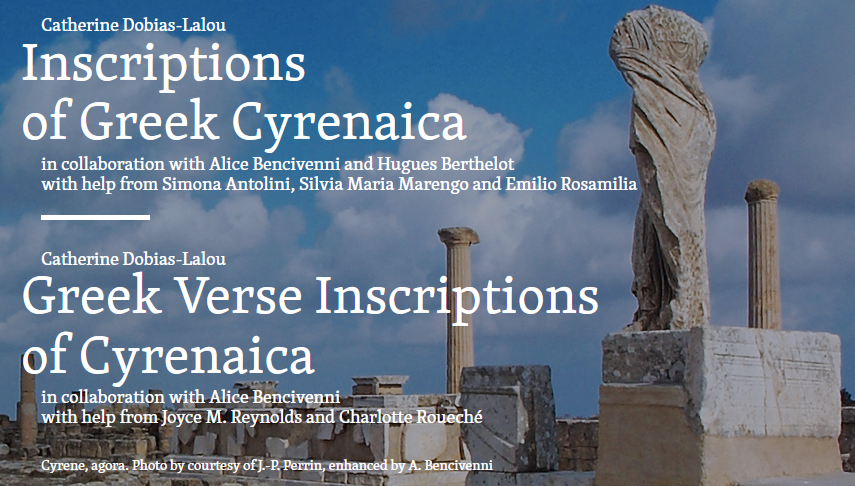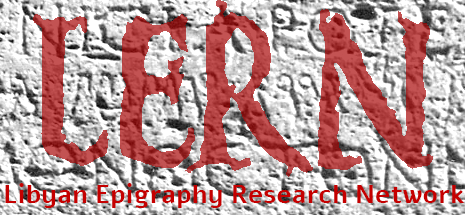
Depuis l’origine, le projet de corpus épigraphique de Cyrénaïque est collaboratif et international, avec un partage décidé en 1980 entre J. Reynolds chargée des inscriptions — grecques et latines — de la période romaine, et les Français A. Laronde et C. Dobias-Lalou pour les inscriptions antérieures —toutes grecques, rien n’ayant été décidé alors pour les inscriptions métriques. Après des années de recensement et d’étude, la question de la forme concrète de la publication était posée. L’initiative de l’édition numérique est venue en 2009 de Ch. Roueché et G. Bodard, forts de l’expérience acquise avec J. Reynolds pour les Inscriptions of Aphrodisias et les Inscriptions of Roman Tripolitania. Une fois prise la décision d’adopter la même méthode, après la disparition d’A. Laronde en 2011, les collègues de l’Alma Mater Studiorum Università di Bologna ont offert leurs ressources pour donner forme à l’édition numérique. Ainsi, des collègues français (H. Berthelot), italiens (au premier chef A. Bencivenni) et britanniques (Ch. Roueché pour les archives de J. Reynolds) ont uni leurs efforts autour de C. Dobias-Lalou pour préparer les Inscriptions de la Cyrénaïque grecque + Inscriptions métriques grecques de Cyrénaïque. La méthode Epidoc, l’organisation des données dans la base, la présentation formelle des inscriptions, la bibliographie ont été conçues selon les normes déjà fixées pour les IRCyr, afin de produire un ensemble homogène dans la perspective du portail unique InsLib. La mise en ligne est intervenue en 2017. Une deuxième édition se prépare déjà, pour remédier à certains défauts, corriger des erreurs, inclure des nouveautés ou des inscriptions oubliées et adopter une conception et une présentation encore plus proches des IRCyr2020. Sa mise en ligne est prévue pour le début de l’année 2023, toujours par l’Alma Mater Studiorum Università di Bologna.
Il progetto del corpus delle iscrizioni dalla Cirenaica è stato fin dall’inizio collaborativo e internazionale, con una ripartizione decisa nel 1980 tra J. Reynolds, responsabile delle iscrizioni greche e latine del periodo romano, e i francesi A. Laronde e C. Dobias-Lalou per le iscrizioni del periodo precedente, tutte in greco; nulla fu deciso allora per le iscrizioni metriche. Dopo anni di ricognizioni e di studio, si pose il problema della forma concreta della pubblicazione. L’iniziativa dell’edizione online fu presa da Ch. Roueché e G. Bodard, che l’avevano sperimentata per le Inscriptions of Aphrodisias e le Inscriptions of Roman Tripolitania. Una volta presa la decisione di applicare la stessa metodologia, e dopo la scomparsa di A. Laronde nel 2011, i colleghi dell’Alma Mater Studiorum Università di Bologna hanno offerto le loro risorse per dar forma all’edizione digitale. Così colleghi francesi (H. Berthelot), italiani (soprattutto A. Bencivenni) e inglesi (Ch. Roueché per gli archivi di J. Reynolds) hanno unito i loro sforzi intorno a C. Dobias-Lalou per preparare le Iscrizioni della Cirenaica greca + Iscrizioni metriche greche della Cirenaica. L’uso di EpiDoc, l’organizzazione dei dati, la presentazione formale delle iscrizioni e la bibliografia sono stati concepiti secondo le norme già fissate per le IRCyr, con lo scopo di produrre un insieme omogeneo nella prospettiva del portale unico InsLib. La pubblicazione online è avvenuta nel 2017. Si sta preparando già una seconda edizione, per porre rimedio ad alcune mancanze, correggere alcuni errori, includere novità o iscrizioni tralasciate e adottare una concezione e una presentazione ancora più vicine a IRCyr2020. La sua pubblicazione online è prevista per l’inizio del 2023, sempre presso l’Alma Mater Studiorum Università di Bologna.
Since its origin, the project of a corpus of inscriptions from Cyrenaica has been collaborative and international, as the division was decided in 1980 between J. Reynolds, in charge of the Greek and Latin inscriptions of the Roman period, and the French A. Laronde and C. Dobias-Lalou for the earlier inscriptions, all of them Greek ones; nothing had been decided at the time about the verse-inscriptions. After years spent in checking and studying, the question of the material shape of the publication arose. The initiative of publishing online was taken by Ch. Roueché and G. Bodard, based on their experience of publishing with J. Reynolds Inscriptions of Aphrodisias and Inscriptions of Roman Tripolitania. Once we had decided to apply the same methodology and after A. Laronde died in 2011, colleagues from Alma Mater Studiorum Univeristà di Bologna proposed to provide their own resources for the online publication. Thereafter, scholars from France (H. Berthelot), Italy (mainly A. Bencivenni) and UK (Ch. Roueché, with J. Reynolds’ archive) worked together with C. Dobias-Lalou for the preparation of Inscriptions of Greek Cyrenaica + Greek Verse-Inscriptions of Cyrenaica. The Epidoc method, the organisation of data in the base, the display of the inscriptions and the bibliography were conceived with the standards already decided for IRCyr, aiming at providing a homogenous set which might belong later to one and the same portal InsLib. The corpus was launched in 2017. A second edition is already currently prepared, in order to cancel flaws, to correct errors, to include new finds and some omitted inscriptions, and also to obtain a design and layout even nearer to that of IRCyr2020. The launch is scheduled for early 2023, still care of the Alma Mater Studiorum Università di Bologna.
